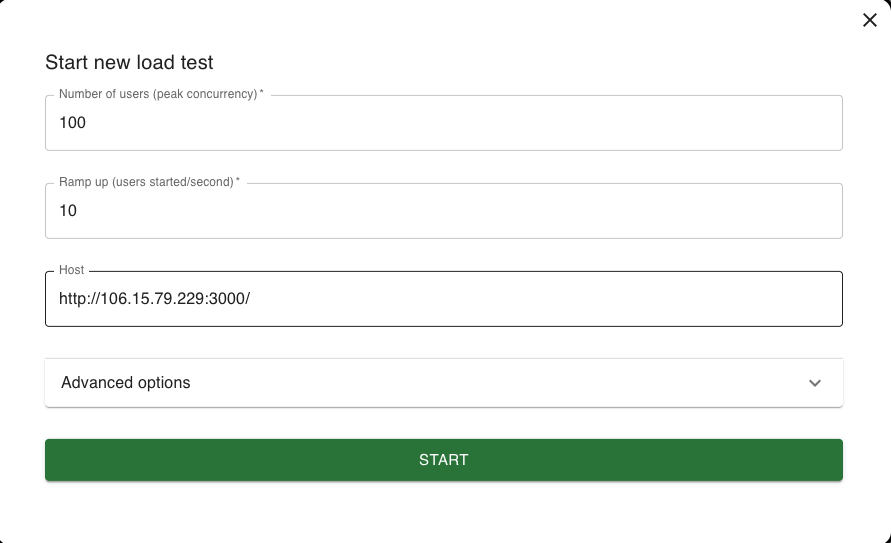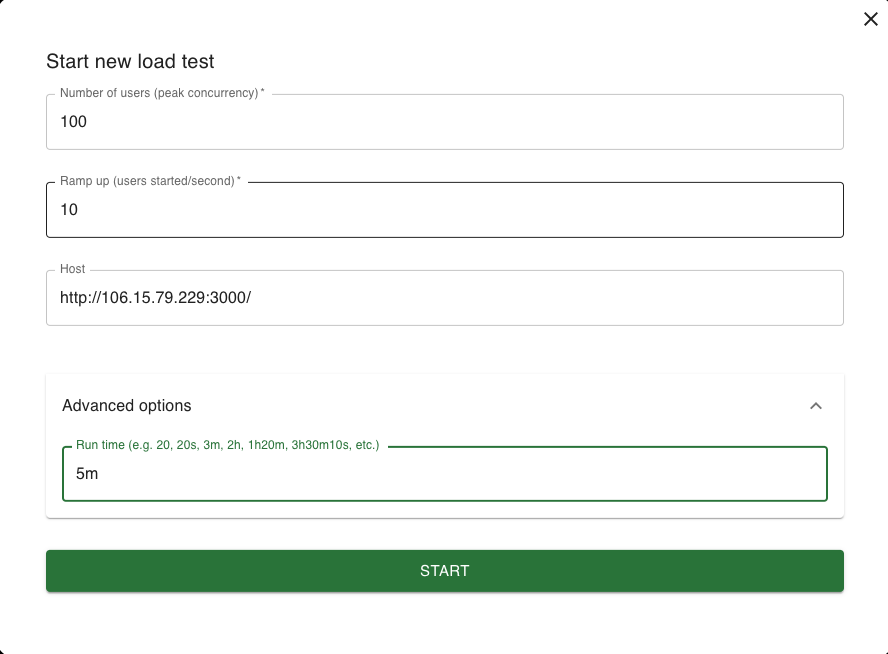Locust
1. 使用locust进行性能测试
locustfile.py
py
from locust import HttpUser, task, between
class MyUser(HttpUser):
# 模拟用户之间的等待时间:1 到 2 秒之间随机等待
wait_time = between(1, 2)
# 测试任务:请求 /playlist/catlist
@task
def get_catlist(self):
self.client.get("/playlist/catlist")
# 测试任务:请求 /playlist/hot
@task
def get_hot_playlists(self):
self.client.get("/playlist/hot")Locust Web UI 配置
TIP
- Number of users to simulate:模拟的用户数。例如,设置为 100,表示模拟 100 个并发用户
- Spawn rate (users spawned/second):每秒启动的用户数。比如设置为 10,表示每秒启动 10 个用户,直到模拟的用户数达到 100
- Host:如果你没有在命令行中指定 --host 参数,你可以在这里手动设置目标主机地址:http://106.15.79.229:3000
- Locust 会在 10秒 内创建并启动 100 个用户。接下来,测试会继续执行,模拟这些 100 个用户对系统进行请求,直到你手动停止测试或根据测试配置停止

请求概览
| Type | Name | # Requests | # Fails | Median (ms) | 95%ile (ms) | 99%ile (ms) | Average (ms) | Min (ms) | Max (ms) | Average size (bytes) | Current RPS | Current Failures/s |
|---|---|---|---|---|---|---|---|---|---|---|---|---|
| GET | //playlist/catlist | 10072 | 0 | 17 | 650 | 1100 | 128.18 | 5 | 3343 | 9111.09 | 34.2 | 0 |
| GET | //playlist/hot | 10127 | 0 | 10 | 230 | 640 | 51.18 | 5 | 6839 | 3181 | 31.3 | 0 |
| Aggregated | Total | 20199 | 0 | 12 | 450 | 860 | 89.58 | 5 | 6839 | 6137.97 | 65.5 | 0 |
总结
TIP
- 本次测试中的系统表现良好,所有请求都成功,响应时间保持在较低范围内,吞吐量也比较可观。
- /playlist/catlist 接口在高负载下的响应时间有一定的波动,特别是 99 百分位响应时间达到 1100ms,但仍然在可接受范围内。
- /playlist/hot 接口的响应时间较为稳定,尤其在 95% 和 99% 百分位的响应时间较低,表明该接口的性能较好
2. 使用locust进行压力测试
locustfile.py
py
from locust import HttpUser, task, between
class StressTestUser(HttpUser):
wait_time = between(0.5, 1) # 每个请求后等待时间:0.5到1秒之间随机
@task
def catlist_page(self):
self.client.get("/playlist/catlist") # 请求接口1
@task
def hot_page(self):
self.client.get("/playlist/hot") # 请求接口2Locust Web UI 配置
TIP
- Number of users to simulate:模拟的用户数。例如,设置为 100,表示模拟 100 个并发用户
- Spawn rate (users spawned/second):每秒启动的用户数。比如设置为 10,表示每秒启动 10 个用户,直到模拟的用户数达到 100
- Host:如果你没有在命令行中指定 --host 参数,你可以在这里手动设置目标主机地址:http://106.15.79.229:3000
- run time: 5m
- Locust 会在 10秒 内创建并启动 100 个用户。接下来,测试会继续执行,模拟这些 100 个用户对系统进行请求,持续5分钟

请求概览
| Type | Name | # Requests | # Fails | Median (ms) | 95%ile (ms) | 99%ile (ms) | Average (ms) | Min (ms) | Max (ms) | Average size (bytes) | Current RPS | Current Failures/s |
|---|---|---|---|---|---|---|---|---|---|---|---|---|
| GET | //playlist/catlist | 9131 | 0 | 840 | 4000 | 7700 | 1298.09 | 7 | 52430 | 9398.41 | 31.1 | 0 |
| GET | //playlist/hot | 9056 | 0 | 230 | 1500 | 3600 | 442.38 | 5 | 9388 | 3181 | 28.6 | 0 |
| Aggregated | - | 18187 | 0 | 440 | 3300 | 7000 | 872 | 5 | 52430 | 6302.53 | 59.7 | 0 |
总结
TIP
- catlist 接口 的响应时间明显高于 hot 接口,尤其是在高百分位(95% 和 99%)的响应时间。catlist 接口表现出较大的波动,尤其是最大响应时间(52,430 ms)。
- hot 接口 的响应时间相对较低,表现较为平稳。